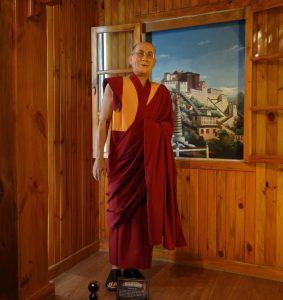Daniel Kahneman Meets Dalai Lama
 Mindfulness as a method for avoiding thinking errors
Mindfulness as a method for avoiding thinking errors
Posted: July 11, 2016 ~ Written by: W.B. “Bud” Kirchner
“The true value of a human being is determined primarily by the measure and the sense in which he has attained liberation from the self.” – Albert Einstein
What could possibly come from a meeting between an individual who is one of only two psychologists to win the Nobel Prize for Economics and one of the most introspective spiritual (Buddhist) and political (Tibetan) leaders?
Context
By way of clarification before we get too far into this topic. My comments are focused on mindfulness (most typically described as “Paying attention in a particular way; on purpose, in the present moment and non-judgmentally.” – (Jon Kabat- Zinn) and meditation which is one way (as is yoga, Alexander technique etc.) to achieve mindfulness. In fact, any routine activity can be made into a mindfulness practice when you bring your full attention to it.

I am not necessarily referring to religions such as Zen which is a Japanese school of Mahayana Buddhism emphasizing the value of meditation to make contact with the inner self.
In short mindfulness as I am writing about it can be a purely secular practice – with no spiritual undertones (unless you want them) and achieved in any way you want.
In fact the dynamic duo of experiencing nature in the mid-19th century – Ralph Waldo Emmerson and Henry David Thoreau were proponents of mindfulness. As Thoreau expressed it “When properly cultivated, such awareness can discern, embrace, transcend and free us from the veils and limitations of our routinized thought patterns, our routinized senses, and routinized relationships, and from the frequently turbulent and destructive mind states and emotions that accompany them.”
This concept is dead center in regards to the Business Brain Model so it is important to have on your radar screen – assuming you are anywhere near the world of business, you will be affected – whether when it comes to not only decisions making, but empathy, stress management etc.
The Problem
I have written thousands of words on the problem associated with decision making based primarily on the work of two behavioral economists – Dan Ariely and Daniel Kahneman under headings such as:
- Thinking Errors: Part 1 Is your Radar set to Detect Cognitive Traps?
- Thinking Errors: Part Two The Ironic Magnitude of Cognitive Biases
- Freaking out about the guy the “Freakonomics” guy freaks out about
- Hooked on Hedonics: Is Happiness the next Holy Grail of Business?
In particular, the work of Kahneman as reflected in “Thinking, Fast and Slow” is salient to today’s discussion.
The bottom line is we are not good at making decisions – in a (depressing) nutshell – We do not act rationally.
As Tetlock and Gardner described it in their book “Superforecasters”:
“As we saw, people can, in principle, use conscious System 2 reflection to catch mistakes arising from rapid, unconscious System 1 operations. Superforecasters put enormous effort into doing just that. But the continuous self-scrutiny is exhausting, and the feeling of knowing is seductive.”
The Cause
One popular explanation for our lack of rationale thinking is that we are stuck on “autopilot”. In fact, Daniel Gilbert and Matthew Killingworth estimated almost 50% (46.9%) of our time is caught up in ‘mind wandering’.

Photo Credit – Brian D’Cruz Hypno Plus
Lest this seem abstract – recall how many times you travel somewhere only to realize you don’t remember the journey (or why you went there?).
“Living this way we often fail to notice the beauty of life, fail to hear what our bodies are telling us and we all too often become stuck in mechanical conditioned ways of thinking and living that may be harmful to ourselves or others.” – Mrs. Mindfulness
The salient work on this is by Farb et.al. “Attending to the present: mindfulness meditation reveals distinct neural modes of self-reference.”
“These results suggest a fundamental neural dissociation between two distinct forms of self-awareness that are habitually integrated but can be dissociated through attentional training: the self across time and in the present moment.”
As with previous blogs – I will stick with my protocol of not going too far into the weeds. However, in this case, I think it is important to illustrate evidence goes way beyond the empirical.
Farb and his colleagues as cited by David Rock (“New Study Shows Humans Are on Autopilot Nearly Half the Time”) confirmed that individuals have two separate ways of interacting with the world around them.
- A so-called “default” network which is also called “narrative”
- This network involves areas of the medial prefrontal cortex as well as the memory/hippocampus
- This network becomes active when not much else is happening and you think about self-reflecting
- In action this network involves planning and daydreaming
- This network also becomes active when you think about yourself or others in a narrative context involving past and future
- The narrative network dominates most of your thoughts!
- The Farb studies also documented another process – “direct” experience.
- This network involves the insula (relating to body sensation) and the anterior cingulate cortex (region central to switching your attention)
- When activated you are not thinking about past/future or yourself/others
- In contrast to the narrative network when using direct network your thoughts are dominated by sensory experience
The narrative and direct experience are contrary in nature – when you are lost in thought you fail to sense the world around you
“Experiencing through the direct experience network allows you to get closer to the reality of any event.” – Farb
The Solution
 “The good of meditation isn’t to control your thoughts it’s to stop letting your thoughts control you.” – Meditation Shift
“The good of meditation isn’t to control your thoughts it’s to stop letting your thoughts control you.” – Meditation Shift
Regular meditators have strong differentiation between the paths – they know which path they are on at any time and can switch back and forth.
A study by Kirk Brown found that people high in the mindfulness scale were more aware of the unconscious.
Again in the words of Farb’s colleagues (Williams, M., Teasdale, J., Segal, Z., Kabat-Zinn, J. – The Mindful Way through Depression.) “This hypothesised cortical reorganization following MT (mindfulness meditation training) is consistent with the notion that MT allows for a distinct experiential mode in which thoughts, feelings and bodily sensations are viewed less as being good or bad or integral to the ‘self’ and treated more as transient mental events that can be simply observed.”
Perhaps, the best juxtaposition (competition?) occurs in the “Ultimatum Game”.
All participants played the same “ultimatum game.” which has been used in a number of behavorial economic studies. The game involves a two-person exchange in which a “proposer” offers to split $20 with a “responder.” The responder has the option to accept or reject the offer. If the offer is accepted, each participant gets their prorata sum of the offer, however if the offer is rejected by the responder they both get nothing.
“In summary, when assessing unfairness in the Ultimatum Game, meditators activate a different network of brain areas compared with controls enabling them to uncouple negative emotional reactions from their behavior. These findings highlight the clinically and socially important possibility that sustained training in mindfulness meditation may impact distinct domains of human decision-making.” – Interoception drives increased rational decision-making in meditators playing the ultimatum game – Kirk Ulrich, Jonathan Downar and P. Read Montague
As an illustration that the decision making benefits aren’t limited to the Ultimatum Game context – researchers from INSEAD and Wharton (Debiasing the Mind Through Meditation, Mindfulness and the Sunk-Cost Bias – Andrew C. Hafenbrack , Zoe Kinias and Sigal G. Barsade) looked at another Kahneman favorite theme ‘sunk cost’.
I quote their abstract:
“We found that the sunk-cost bias was attenuated by drawing one’s temporal focus away from the future and past and by reducing state negative affect, both of which were accomplished through mindfulness meditation.”
More Details
There is a lot to digest when it comes to mindfulness and I plan to write more on this topic in the (near) future, in the meantime, here are some additional perspectives beyond decision making.
The bibliography related to the world of mindfulness and/or meditation grows daily but if you want to go to the roots here are three of the classics.
- Full catastrophe living: Using the wisdom of your body and mind to face stress, pain, and illness – Jon Kabat-Zinn and Thich Nhat Hanh
- Wherever You Go, There You Are: Mindfulness Meditation in Everyday Life – Jon Kabat-Zinn
- Full catastrophe living: How to cope with stress, pain and illness using mindfulness meditation – Jon Kabat-Zinn and Joan Z. Borysenko
There are, of course, documented benefits of mindfulness beyond its ability to help you get off of ‘automatic pilot’ and thus make better decisions. There are no shortages of references to turn to but in the realm of health:
- Mindfulness for Health – Dr. Danny Burch
- Mindfulness Training Has Positive Health Benefits – Northern Arizona University
If you want to venture into the more spiritual realms:
- Zen Mind Beginner’s Mind – Shunryu Suzuki
- Three Pillars of Zen – Philip Kapleau Roshi
“You should sit in meditation for 20 minutes a day unless you are too busy – in which cause you should sit for an hour.” – Zen adage
